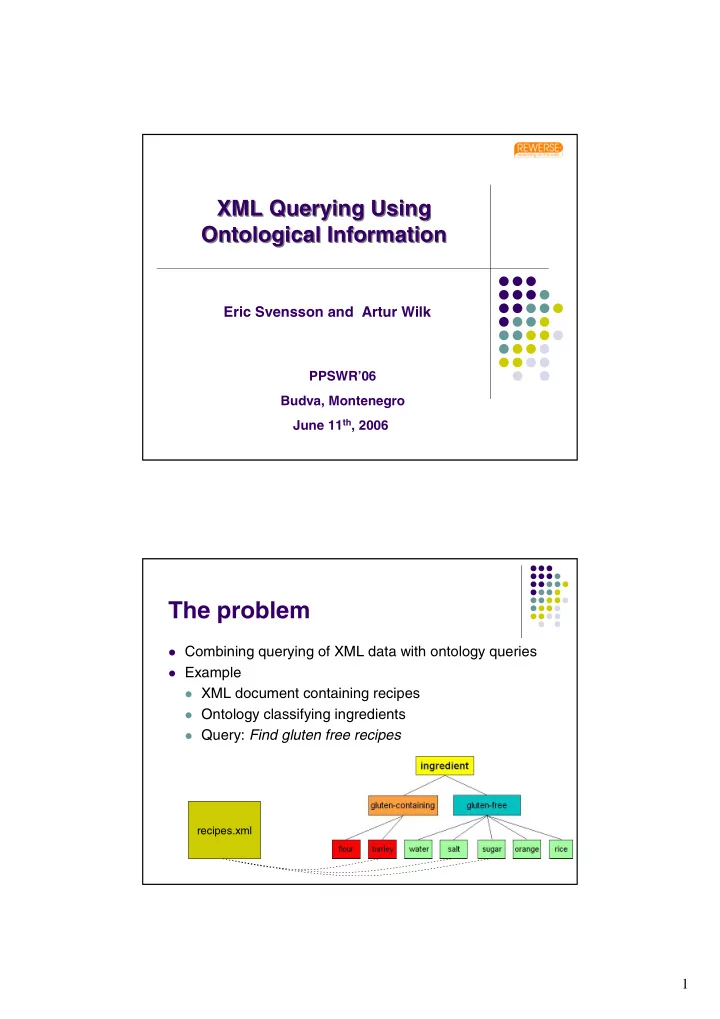

XML Querying Using XML Querying Using Ontological Information Ontological Information Eric Svensson and Artur Wilk PPSWR’06 Budva, Montenegro June 11 th , 2006 The problem � Combining querying of XML data with ontology queries � Example � XML document containing recipes � Ontology classifying ingredients � Query: Find gluten free recipes recipes.xml 1
The approach � XML query language: Xcerpt � extended with ontology interface � DIG � Ontology reasoner June 11th, 2006 3 Outline � Preliminaries Xcerpt � ontologies and DIG interface � � Extended Xcerpt Answer filtering � Ontological information retrieval � � Conclusions June 11th, 2006 4 2
Xcerpt - Introduction Xcerpt – query and transformation language for XML [Schaffert et al ., 2004] � inspired by logic programming � uses pattern matching instead of path navigation � programs consist of query rules c ← Q � the body Q used to extract XML data � the head c used to build new XML data � Core constructs: data terms, query terms, construct terms June 11th, 2006 5 Xcerpt constructs � Data terms model XML documents � <CD price="$10.90"> CD[ attr{ price[ “$10.90” ] }, <title>Empire Burlesque</title> title[attr{ }, “Empire Burlesque”], <artist>Bob Dylan</artist> artist[ attr{ }, “Bob Dylan” ] </CD> ] � Query terms used to match data terms � successful matching results in variable bindings (answer � substitutions), e.g. Query term Data term Matches? Answers a[ X ] a[ “c” ] yes { X / “c” } a[[ X ]] a[ “b”, “c” ] yes { X / “b” }, { X / “c” } 3
Xcerpt constructs: Construct Terms and Query Rules � Construct term used to build data terms (by applying answer substitutions) � may contain � � variables e.g. c[ X ] � grouping constructs all and some � Query rule c ← Q Q – query terms � � connected using and , or … � possibly associated with external resources c – construct term, � June 11th, 2006 7 Ontologies � Describe application domains � Concepts � Individuals: instances of concepts � Roles: binary relations between individuals � Specified by special languages e.g. OWL � Handled by ontology reasoners e.g. RacerPro June 11th, 2006 8 4
DIG interface � ontology reasoner interface � communication through HTTP POST requests � XML encoded messages Tell : managing the knowledge base � Ask : querying the knowledge base � Response : replying to the queries � <children> Ask <catom name=“ gluten-containing ”/> </children> <conceptSet> <synonyms> <catom name=“ flour ”/> </synonyms> Response <synonyms> <catom name=“ barley ”/> </synonyms> </conceptSet> June 11th, 2006 9 Extended Xcerpt � Xcerpt + ontology reasoner interface � Communicates with a reasoner using DIG � Two methods of interaction � answer filtering � ontological information retrieval June 11th, 2006 10 5
Answer filtering Xcerpt rule Extended Xcerpt rule Answer filtering – example Query: Find recipes with ingredients containing gluten GOAL recipes[ names [ all var R ] ] recipe[ FILTER name[ " Recipe1 " ], !dig [ ingredients[ ingr[ name[ "sugar" ], "http://localhost:14159/", ingr[ name[ "orange" ] ] ] subsumes [ recipe[ catom [ attr { name [ "gluten-containing" ] } ], name[ " Recipe2 " ], catom [ attr { name [ var N ] } ] ingredients[ ingr[ name[ "flour" ], ] ingr[ name[ "salt" ] ] ] ] ] FROM Answer substitutions: in [ resource [ "file:recipes.xml" ], desc recipe [[ R N name [ var R ], “Recipe1” “sugar” desc ingr [[ name [ var N ] ]] ]] “Recipe1” before “orange” ] filtering “flour” “Recipe2” END “salt” “Recipe2” rule result: names [ “Recipe 2”] after “Recipe2” “flour” filtering 6
Ontological Information retrieval � DIGging rule: ( h r ← b r ) ( h a ← b a ) June 11th, 2006 13 Ontological Information retrieval � simple DIGging rule: ( h r ← b r ) h a (fixed ask expression) 14 7
Ontological information retrieval � The prototype � simple DIGging rules incorporated into Xcerpt goal rules GOAL h r ( h r ← b r ) h a = FROM in[ !dig[ URL, h a ], b r ] END June 11th, 2006 15 Ontological information retrieval - example GOAL results [ all var C ] FROM in [ !dig [ "http://localhost:14159/", Query result: asks [ children [ results [ attr{ id [ "q1" ] }, "water", catom [[ attr { name [ "gluten-free" ] } ]] "rice", ] "salt", ] ], "orange", responses {{ "sugar" conceptSet {{ ] attr { id [ "q1" ] }, synonyms [[ catom [[ attr { name [ var C ] } ]] ]] }} }} ] END 8
DIGging rules limitation � variable bindings cannot be passed between ask and response rule e.g. ask[ instance[ I , C ] ] ← q[ I , C ] instance[..] ← response{{ desc “yes” }} June 11th, 2006 17 Summary Extension of Xcerpt allowing to communicate with an ontology � reasoner answer filtering � � prototype no grouping constructs in filters � filters only in goal rules � ontology information retrieval � � cannot be directly used for filtering (no variable passing) � prototype simple DIGging rules � response rule only as a goal rule � 9
Related work � Datalog + DL with logical semantics AL-log [98], CARIN[98],Rosati[05], Motik et al [05] not applicable to Xcerpt + OWL � � Hybrid framework with fixpoint semantics [Assmann et al ] � ontology reasoning after rule reasoning � Our approach � required modification of Xcerpt system � ontology reasoning interleaved with rule reasoning � DIGging rules 19 Future work � variable passing in DIGging rules � hybrid implementation � DIGging rules handled by external application � Xquery + ontologies ? June 11th, 2006 20 10
Recommend
More recommend